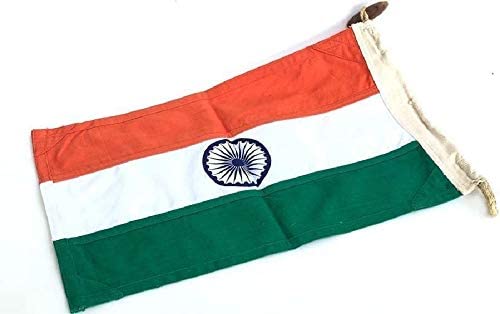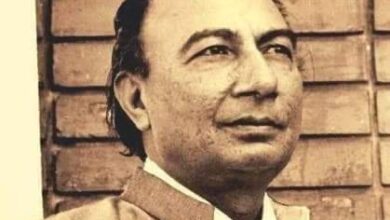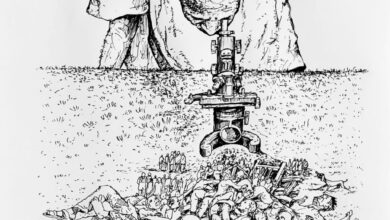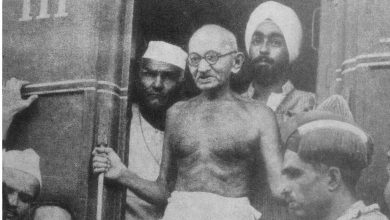Khadi: The heart of the National Flag of India
Siby K. Joseph

Gandhi took the leadership of the national movement in 1920. In a speech delivered at the opening ceremony of Lokamanya National School at Ankleshwar on November 2, 1920, Gandhi said “The flag that flies over the schools today is the flag of a Satanic Government. He considered that we make our children slaves by educating them in those schools over which fly the satanic flag. Later in an article written in Navajivan on March 20, 1921 Gandhi floated the idea of the “ Flag of Swaraj.” He wrote “A wise friend has suggested that the picture on our swaraj flag must be that of the spinning-wheel. This idea has appealed to me as very beautiful. … But I find no other idea as attractive as that of having a spinning wheel on the flag of swaraj. I commend this idea to the leaders who will be in charge of the forthcoming Congress session.”

Gandhi further reflected on it in an article entitled “The National Flag” in Young India on April 13,1921 and gave a call to all Indians following various religious traditions to recognize a common flag to live and to die for. He further suggested that “those who believe with me will make haste to introduce the spinning-wheel in their home and possess a national flag of the design suggested by me. It follows that the flag must be made of khaddar, for it is through coarse cloth alone that we can make India independent of foreign markets for her cloth.” By 1921 the national flag became the part and parcel of the freedom movement and the Indian National Congress. The national flag made of khaddar symbolized the ideals of the freedom movement and it was the flag of swaraj for every Indian.
Satish D. Kalelkar, son of Kaka Kalelkar wrote a piece in Harijan on July 6, 1947 suggesting that our wheel may have three stripes of red, white and green (of the mother earth and her children the tillers) with a wheel with eight spokes superimposed in any suitable colour. Gandhi added the following postscript to Satish Kalelkar’s article “As the originator of the first design, I should say that the three stripes were to represent all the communities and the charkha was the symbol of non-violence.” The suggestions for improvement of the National flag were in the air before the transfer of power to India by the British government. It was a point of reference in Gandhi’s speeches and writings too. In a prayer meeting in New Delhi on July 22, 1947 Gandhi said “I am told that instead of the charkha there is only a wheel on the flag. But it is all the same to me whether they keep or do not keep the charkha. Even if they cast it away I will still have it in my hand and in my heart. Further he said “A friend tells me that the charkha is still there on the flag. Another friend tells me that it is not there, that it has been discarded even while I am still alive. I do not know. What I do know is that even if the charkha was shown on the flag but was not in people’s hearts, both the flag and the charkha would be fit only to be burnt. But if the charkha had a place in the hearts of the people, then it would not matter whether it was placed on the flag or not.”( Prarthana Pravachan–I, pp. 269–72) Thus it is clear that Gandhi wanted Charkha should remain in the hearts of the people of independent India.
Gandhi was not ready to accept the argument that the original flag had gone and the new flag of independent India will be one to fit this new age. He wrote “People are saying ‘the charkha was old women’s solace and Gandhi’s toy; but swaraj is not for old women. It is for the warrior and we therefore want the Asoka emblem with lions and if the lions do not find a place on the flag, it is merely for artistic considerations: they cannot be reproduced on cloth. But the lions must feature somewhere or other. We have had enough of cowardliness. Nobody has yet had the experience of the non-violence of the brave. We shall talk about it when we see it. It is the lion who is the king of the forest. Sheep and goats are his food. We are tired of wearing khadi. Now we shall wear clothes made of glass. Our forefathers used cloth to cover themselves. We wear clothes to adorn ourselves. Clothing therefore should be such as will show to advantage every limb of the body. The improved flag has no need of khadi. We do not want to disfigure with khadi the shop windows of our towns. The poor in the villages may by all means wear khadi. We shall not treat it as an offence. Old women in their huts may spin away on the charkha. In this new age this should be considered a favour.”
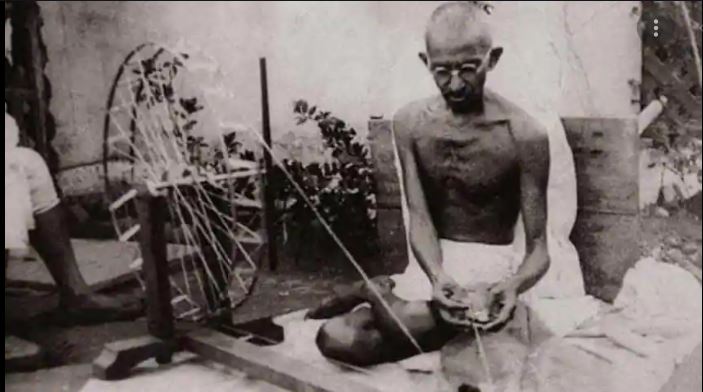
Gandhi was so convinced about the importance of spinning wheel and khadi . In response to it he emphatically said “I will refuse to salute the flag that is modified on the above lines however artistic it may appear.” At the same he was ready to accept the positive side of the argument about the new flag. He wrote: “Happily there is the other side which says: ‘The new flag is merely an improved design of the original. The spinning-wheel continues on it. That it is without the spindle and the mal, is a failing of art. A picture after all is only a picture. It always leaves something for the imagination. The spinning-wheel in a picture has no slivers and no spinners at work on it. These are left for the imagination to fill in. This rule applies as well to the improved design of the flag.” But he was not ready to make any concession on the fabric in which the new tricolor flag should be made and specified it very clearly. He wrote “This tricolour flag with the wheel will certainly consist of hand-spun and handwoven khadi. Our country has called it khadi whether it is woven from hand-spun cotton or silk.” (Harijanbandhu, 3-8-1947).
Independent India after due deliberation in the Constituent Assembly (See Constituent Assembly Debates on 22 July 1947) adopted the modified version of the Swaraj flag. In the new flag, the tricolor remained the same saffron, white and green and the charkha was replaced by the Ashoka Chakara representing the eternal wheel of law. Khadi was the only fabric allowed for the preparation flag, and flying a flag made of any other material was punishable by law with imprisonment up to three years, besides a fine. The Directorate General of Foreign Trade of the Government of India, in a notification ( no.24 2015 /2020) dated 11th October 2019 prohibited the import of the Indian National Flag not adhering to the specifications prescribed under Part – 1 section 1.2 of Flag Code of India 2002 ( See Appendix -1). The Ministry of Home Affairs (Public Section), Government of India (File No. 15/1/ 2021-Public) issued an Flag Advisory dated August 5, 2021 on the subject Strict compliance of the provisions of Flag Code of India 2002 and the prevention of insults to National Honour Act1971.In the advisory, the prevention of insults to National Honour Act1971 and Flag Code of India 2002 were appended. Paragraph 1.2 of Part-I of the Flag Code of India, 2002 appended in the Flag Advisory read as follows: “1.2 The National Flag of India shall be made of hand spun and hand woven wool/cotton/silk khadi bunting.” Thus it is crystal clear that up to August 2021, Khadi was the only fabric allowed for the preparation of national flag.
The Government of India Ministry of Home Affairs (Public Section) in an order dated 30 December, 2021 amended the Flag Code of India (See Appendix-2). With the new amendment paragraph 1.2 of Part-I of the Flag Code of India, 2002 read as follows: “1.2 The National Flag of India shall be made of hand spun and hand woven or machine made, cotton/polyester/wool/silk khadi bunting”. The revised version of the Flag Code of India, 2002, is available on the website of Home Affairs (www.mha.gov.in.) Through this amendment, for the first time in the history of independent India machine- made polyester cloth was permitted for the preparation of the National Flag. The national flag made of Khadi was the unique identity of India and it was a symbol of the values of the freedom movement of the country. Khadi was the fabric of freedom and Mahatma Gandhi was keen that the tricolour flag should be made of hand-spun and hand woven khadi. Thus the new amendment is very much against the values of the freedom movement and the wish of Gandhi.
Despite this decision world’s largest national flag made of Khadi fabric was put on a grand public display along the India – Pakistan Border in Jaisalmer to celebrate “Army Day” on January 15, 2022. As per the Press release of the Ministry of Micro, Small & Medium Enterprises (https://pib.gov.in/PressReleaseIframePage.aspx?PRID=1789943)“This will be the 5th public display of the National Flag since its unveiling in Leh on 2nd October 2021. It was, later on, displayed at Hindon Airbase on the occasion of Air Force Day on 8th October 2021 and at the Red Fort on 21st October 2021, that marked the completion of 100 crore Covid vaccinations in India. On 4th December 2021, the Monumental National Flag was displayed at the Naval Dockyard near Gateway of India in Mumbai to celebrate Navy Day.” The press release further states that “The Monumental National Flag, which symbolizes the collective spirit of Indian-ness and the heritage artisanal craft of Khadi, has been conceptualized and prepared by Khadi and Village Industries Commission (KVIC) to celebrate ‘Azadi ka Amrit Mahotsav’, the 75 years of Independence. KVIC has handed over the flag to the Defence forces for displaying the same at prominent places on historic occasions.” Then the question arises if the government considers the Khadi flag as the collective spirit of Indian-ness and our heritage, why the flag code amended to include machine-made polyester cloth when the nation is celebrating 75 th anniversary of Indian independence?
It is surprising that the amendment of Flag Code of India was not discussed in the mainstream media of our country. However, a news write up appeared on March 2, 2022 in Economic Times. “Centre approves manufacture and import of machine-made polyester national flags” (https://economictimes.indiatimes.com/news/economy/policy/centre-approves-manufacture-and-import-of-machine-made-polyester-national-flags/articleshow/89932131.cms ) Also some news channels covered the news. In April, 2022 Laila Tyabji, Chairperson of Dastkar wrote “ Khadi was the fabric of our Freedom Movement – the spinning of thread on the charkha and the play of warp and weft on the loom wove together the themes of Swadeshi, our traditional hand crafts, and employment and earning for rural communities, especially women. For Gandhi and successive post-Independence generations the flag embodied our identity, our ideals, our hopes and vision for the future. …Now – shock, horror, heartbreak …. The Central Government has just amended the 2002 Flag Code, and allowed the manufacturing and import of machine-made national flags – made using polyester!” Dastkar also started a petition to protest against the legitimisation of polyester flags. ( https://chng.it/mKWYSLt8yb ) Anil Nauriya writer and counsel at the Supreme Court wrote in a post wrote “Gandhi had propagated Khadi as it signified and emblemised liberation from the unequal and inequitable exchange prevalent in the colonial economy in which raw materials like cotton used to be bought from India and other countries and finished textiles and textiles products sold to them in return.Jawaharlal Nehru had famously described Khadi as ‘the livery of freedom”. I was reminded of this when I saw on television today an Indian dignitary visiting Europe and I failed to recognise the Indian tricolour displayed in the background as being of Khadi material. I hope I was wrong. Incidentally, for some years now many Indian farmers have been taking their own lives on account of adverse financial conditions. Ironically, a large number of these are cotton-growers who have suffered because of the vagaries of international trade.”
The Prime Minister of India had praised Khadi Village Industries Commissions initiative of world’s largest Khadi National Flag displayed in Leh, Ladakh as a tribute to Mahatma Gandhi on October 2, 2021. He wrote on Twitter “This is a unique tribute to respected Bapu, whose passion towards Khadi is widely known. This festive season, do consider making Khadi and handicraft products a part of your lives and strengthen the resolve to build an Aatmanirbhar Bharat.”
If the Government is committed to Atma Nirbhar Bharat it should withdraw the recent amendment of flag code of India and make Khadi as the only cloth for preparation of national flag. All patriotic people who have imbibed the spirit of freedom movement and respect Gandhian values should demand the withdrawal of new amendment of Flag Code of India. This will be the greatest tribute we can give to the Father of the Nation on the eve 75 th anniversary of Indian independence.
Please also read this
About the Author
Dr. Siby K. Joseph is noted Gandhian Scholar and Director,Sri Jamnalal Bajaj Memorial Library and Research Centre, Sevagram AshramPratishthan,Sevagram, Wardha-442102,Maharashtra .
Email:director jbmlrc@gmail.com

